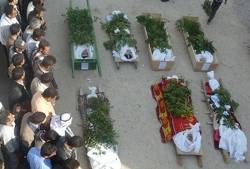In tumultuous Syrian city, kidnapping trade booms
29/01/2012| IslamWeb
When he got in the taxi, the Syrian worker unwittingly walked into the hands of kidnappers. Dumped blindfolded in a graveyard eight days later, he was glad to be alive.
Abu Ahmed, a 35-year-old house painter, is one of hundreds in the Syrian city of Homs who have fallen prey to a growing sectarian kidnapping trade fuelled by increasing unrest.
State security forces are focused on trying to crush the resistance in Homs, heart of the 10-month uprising against President Bashar al-Assad.
Meanwhile, residents say Homs has become a lawless place where people are dragged away at gunpoint almost daily, targeted solely for their religious identity.
“My captors beat me and mocked me for being Sunni. They tied me to a metal bed and I slept sitting up,” Abu Ahmed said. “Even if they hadn’t tied me up, I wouldn’t have tried to flee. I was terrified. I thought they would kill me.”
In Homs, members of the same minority sect to which Assad himself belongs kidnap Sunni Muslims. Those who are part of the Sunni majority, backbone of protests against 42 years of autocratic Assad family rule, go after Alawites.
So far, sectarian violence and killing are rarely the goals of the abductions. But the kidnapping trend in the city of one million people, Syria’s third largest, has taken on a logic of its own.
Some seize people for money in Homs, where the bloody turmoil paralyzing the city has left thousands jobless. Others kidnap to trade hostages. And some simply feel that having captives on hand could serve as leverage later.
Residents say police write reports but never take action.
Stories like his are hard to verify, as government restrictions and the ongoing violence curb media access. But human rights groups and the government itself have chronicled dozens of kidnapping cases. All of those interviewed spoke by Skype, to avoid the telephone monitoring of security services.
“The frowner”
In Homs, near-empty streets are patrolled by jittery soldiers hiding behind stacked sandbags. Residents shut themselves inside by dusk to avoid kidnappers waiting under the cover of darkness.
Even going out in the daytime is risky now. Jamal was kidnapped at noon.
“I was driving out of the market. Four men with Kalashnikovs waved me down. I sped away because I knew what would happen.”
But a hidden car raced out of an alley and cut him off.
“They dragged me out of my car and beat me. They took my two mobile phones, 2,500 liras ($40) in my pocket and my shoes.”
Jamal was then taken to a house where he was crammed into a room with 10 other people, held hostage for days on end.
“It was the house of a guy people call ‘The Frowner’. He’s a creep. He runs the kidnapping scheme in that neighborhood. It was such a farce, I stopped worrying I would die,” he said.
The kidnappers let Jamal call his family and tell them they needed to pay 150,000 lira (around $2,500) for his release and another 300,000 to get back his car.
Sectarian swaps
“My family is poor. They don’t have much money, so they talked to some of the Alawite thugs in our neighborhood hoping to get some Sunnis released in exchange for me,” Jamal said.
The Alawite sect is an offshoot of Shiism. Under Assad rule, many Alawites were drawn into the political and military elite but others remained deeply poor.
There are exceptions to the sectarian loyalties – some Alawites back the protests and some Sunnis support Assad – but the broad divide between the two communities in Homs even shapes the kidnapping trade.
Not all abductions have a happy ending.
There has been more than one incident of a group of Sunni or Alawite bodies dumped in the street, mutilated. Some worry this foreshadows greater sectarian strife to come.
PHOTO CAPTION
Syrians pray next to the bodies of people who were among the Sunni Muslims killed in Hula near Homs.
Source: Reuters
www.islamweb.net

